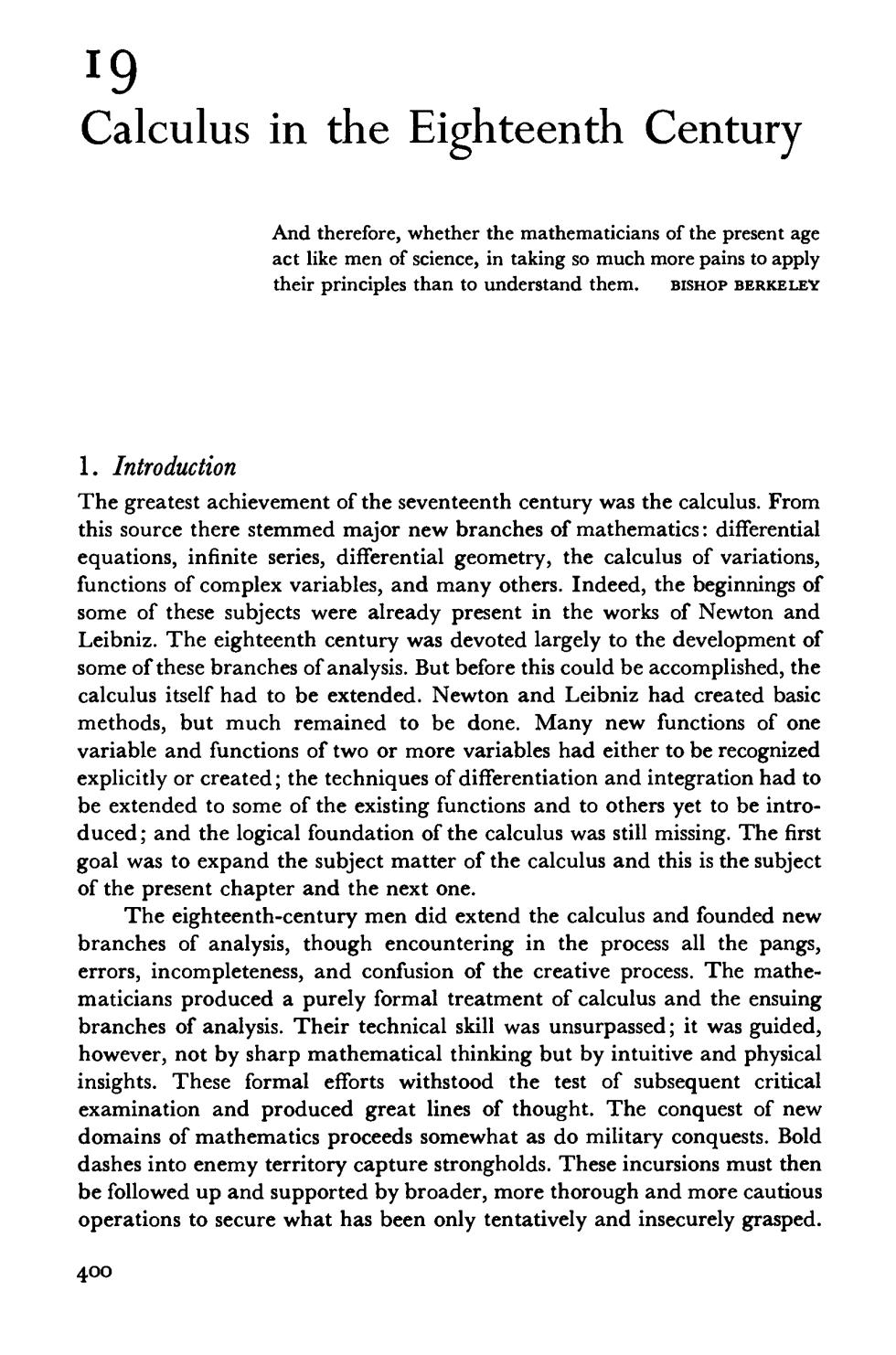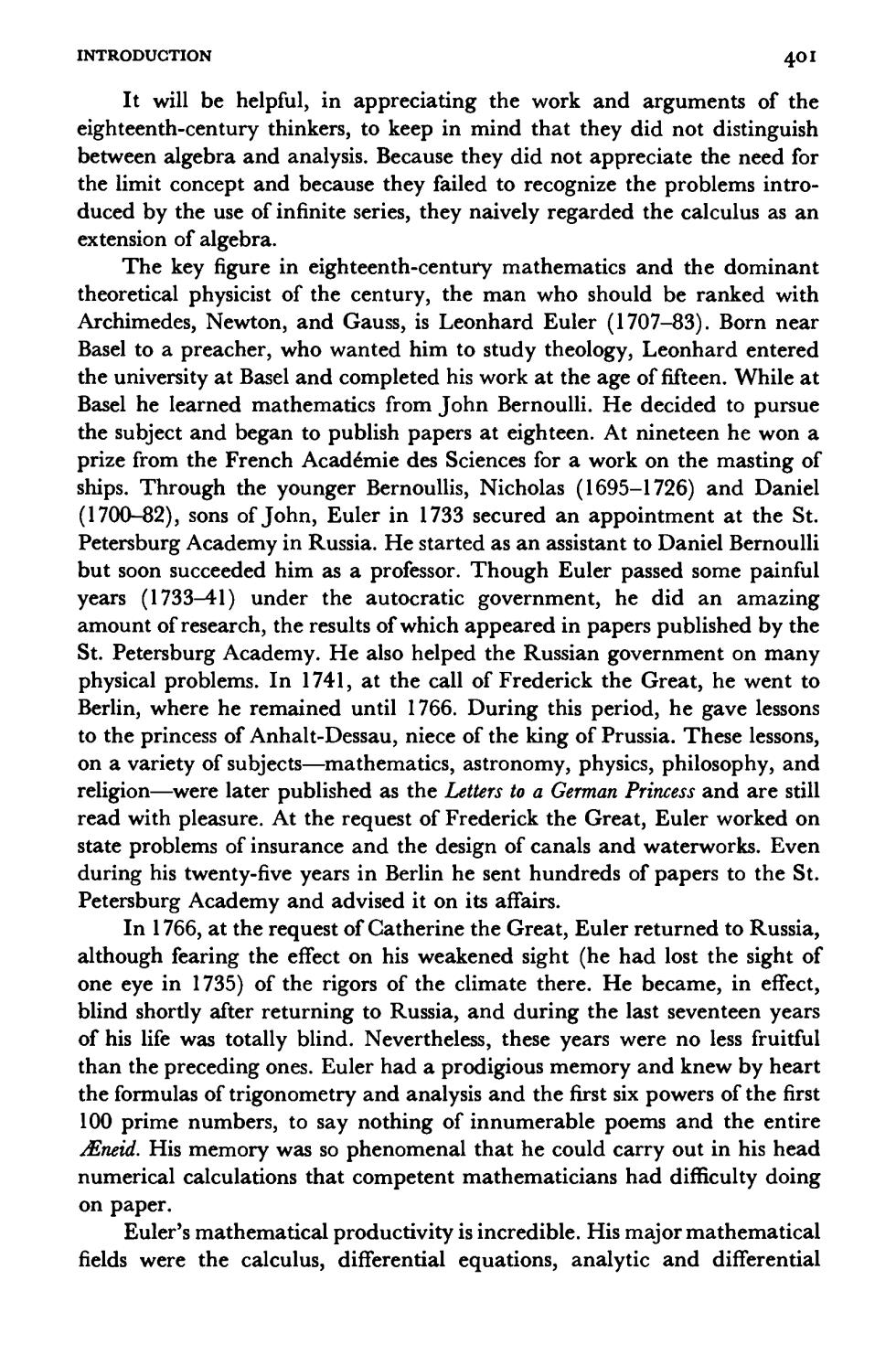
IQ Calculus in the Eighteenth Century And therefore,whether the mathematicians of the present age act like men of science,in taking so much more pair their principles than to understand them. s to apply BISHOP BERKELEY 1.Introduction The greatest achievement of the seventeenth century was the calculus.From this source there stemmed major new branches of mathematics:differential equations,infinite series,differential geometry,the calculus of variations functions of complex variables,and many others.Indeed,the beginnings of sme of these subjects were already present in the works of Newton and Leibniz.The eighteenth century was devoted largely to the development of some of these branches of analysis.But before this could be accomplished,the calculus itself had to be extended.Newton and Leibniz had created basic methods,but much remained to be done.Many new functions of one variable and functions of two or more variables had either to be recognized explicitly or created;the techniques of differentiation and integration had to be extended to some of the existing functions and to others yet to be intro- duced;and the logical foundation of the calculus was still missing.The first goal was to expand the subject matter of the calculus and this is the subject of the present chapter and the next one The eighteenth-century men did extend the calculus and founded new branches of analysis,though encountering in the process all the pangs errors,incompleteness,and confusion of the creative process.The mathe maticians produced a purely formal treatment of calculus and the ensuing branches of analysis.Their technical skill was unsurpassed;it was guided, however,not by sharp mathematical thinking but by intuitive and physical insights.These formal efforts withstood the test of subsequent critical examination and produced great lines of thought.The conquest of new domains of mathematics proceeds somewhat as do military conquests.Bold dashes into enemy territory capture strongholds.These incursions must then be followed up and supported by broader,more thorough and more cautious operations to secure what has been only tentatively and insecurely grasped. 400

INTRODUCTION 401 It will be helpful,in appreciating the work and arguments of the eighteenth-century thinkers,to keep in mind that they did not distinguish between algebra and analysis.Because they did not appreciate the need for the limit concept and because they failed to recognize the problems intro- duced by the use of infinite series,they naively regarded the calculus as an extension of algebra. The key figure in eighteenth-century mathematics and the dominant theoretical physicist of the century,the man who should be ranked with Archimedes,Newton,and Gauss,is Leonhard Euler (1707-83).Born near Basel to a preacher,who wanted him to study theology,Leonhard entered the university at Basel and completed his work at the age of fifteen.While at Basel he learned mathematics from John Bernoulli.He decided to pursue the subject and began to publish papers at eighteen.At nineteen he won a prize from the French Academie des Sciences for a work on the masting of ships.Through the younger Bernoullis,Nicholas (1695-1726)and Daniel (1700-82),sons of John,Euler in 1733 secured an appointment at the St Petersburg Academy in Russia.He started as an assistant to Daniel Bernoulli but soon succeeded him as a professor.Though Euler passed some painful years (1733-41)under the autocratic government,he did an amazing amount of research,the results of which appeared in papers published by the Petersburg Academy.He also helped the Russian government on many physical problems.In 1741,at the call of Frederick the Great,he went to Berlin,where he remained until 1766.During this period,he gave lessons to the princess of Anhalt-Dessau,niece of the king of Prussia.These lessons, on a variety of subjects -mathematics,astronomy,physics,philosophy,and religion- -were later published as the Letters to a German Princess and are still read with pleasure.At the request of Frederick the Great,Euler worked on state problems of insurance and the design of canals and waterworks.Even during his twenty-five years in Berlin he sent hundreds of papers to the St. Petersburg Academy and advised it on its affairs In 1766,at the request of Catherine the Great,Euler returned to Russia, although fearing the effect on his weakened sight (he had lost the sight of one eye in 1735)of the rigors of the climate there.He became,in effect, blind shortly after returning to Russia,and during the last seventeen years of his life was totally blind.Nevertheless,these years were no less fruitful than the preceding ones.Euler had a prodigious memory and knew by heart the formulas of trigonometry and analysis and the first six powers of the first 100 prime numbers,to say nothing of innumerable pocms and the entire Eneid.His memory was so phenomenal that he could carry out in his head numerical calculations that competent mathematicians had difficulty doing on paper. Euler's mathematical productivity is incredible.His major mathematical fields were the calculus,differential equations,analytic and differential

402 CALCULUS IN THE EIGHTEENTH CENTURY geometry of curves and surfaces,the theory of numbers,series,and the calculus of variations.This mathematics he applied to the entire domain of physics.He created analytical mechanics(as opposed to mechanics)and the subject of rigid body mechanics.He calculated the perturbative effect of celestial bodies on the orbit of a planet and the paths of projectiles in resisting media.His theory of the tides and work on the design and sailing of ships aided navigation.In this area his Scientia Navalis (1749)and Thdorie complite de la construction et de la des vaisseau (1773)are outstanding.He investigated the bending of beams and calculated the safety load of a column.In acoustics he studied the propagation of sound and musical consonance and dissonance.His three volumes on optical instruments contributed to the design of telescopes and microscopes.He was the first to treat the vibrations of light analytically and to deduce th equation of motion taking into account the dependence on the elasticity and density of the ether,and he obtained many results on the refraction and dispersion of light.In the subject of light he was the only physicist of the eighteenth century who favored the wave as opposed to the particle theory. The fundamental differential cquations for the motion of an ideal fluid are his;and he applied them to the flow of blood in the human body.In the theory of heat,he (and Daniel Bernoulli)regarded heat as an oscillation of molecules,and hisEssay n Fire(1738)won a prize.Chemistry,geography, and cartography also interested him,and he made a map of Russia.The applications ere said to be an exc for his mathematical investigations; but there can be no doubt that he liked both. Euler wrote texts on mechanics,algebra, mathematical analysis analytic and differential geometry,and the calculus of variations that were standard works for a hundred years and more afterward.The ones that will concern us in this chapter are the two-v (1748),the first connected presentation of the calculus and elementary analysis;the more comprehensive Institutiones Calculi Diferentialis(1755);and the three-volume Institutiones Calculi Integralis (1768-70);all are landmarks. All of Euler's books contained some highly original features.His mechanics, as noted,was based on analytical rathe the first significant treatment of the calculus of variations.bevond texts he published original research papers of high quality at the rate of about eight hundred pages a year during most of the years of his life.The quality of these papers may be judged from the fact that he won so many prizes for them that these awar rds became e an almost regular addition to his income. ome of the books and four hundred of his research papers were written after he became totally blind.A current edition of his collected works,when completed,will contain seventy-four volumes. Unlike Descartes or Newton before him or Cauchy after him,Euler did not open up new branches of mathematics. But no one was s so prolific or

THE FUNCTION CONCEPT 403 could so cleverly handle mathematics;no one could muster and utilize the resources of algebra,geometry,and analysis to produce so many admirable results.Euler was superbly inventive in methodology and a skilled technician One finds his name in all branches of mathematics:there are formulas of Euler,polynomials of Euler,Euler constants,Eulerian integrals,and Euler lines. One might suspect that such a volume of activity could be carried on only at the of all other interests.But Euler married and fatherec thirteen children.Always attentive to his family and its welfare he instructed his children and his grandchildren,constructed scientific games for them and spent evenings reading the Bible to them.He also loved to express himself on matters of philosophy;but here he exhibited his only weakness, for which he was often chided by Voltaire.One day he was forced to confes that he had never studied any philosophy and regretted having believed that one could understand that subject without study ing it.But Euler's spirit for philosophic disputes remained undampened and he continued to engage in them.He even enjoyed the sharp criticism he provoked from Voltaire. Surrounded by universal respect well merited by the nobility of his character-he could at the end of his life consider as his pupils all the mathematicians of Europe.On September 7,1783,after having discussed the topics of the day,the Montgolficrs,1 and the discovery of Uranus, according to the oft-cited words of J.A.N.C.de Condorcet,"He ceased to calculate and to live." 2.The Function Concept As we have scen,the concept of a function and the simpler algebraic and transcendental functions were introduced and used during the seventeenth century.As Leibniz,James and John Bernoulli,L'Hospital,Huygens,and Pierre Varignon (1654-1722)took up problems such as the motion of a pendulum,the shape of a rope suspended from two fixed points,motion along curved paths,motion with fixed compass bearing on a sphere (the loxodrome),evolutes and involutes of curves caustic curves arising in the reflection and refraction of light,and the path of a point on one curve that rolls on another,they not only employed the functions already known but arrived at more complicated forms of elementary functions.As a consequence of these researches and general work on the calculus,the elementary func- tions were fully recognized and developed practically in the manner in which we now have them.For example,the logarithm function,which originated 1.The Montgolfiers were two brothers who in 1783 first successfully made an ascent in a balloon filled with heated air

404 CALCULUS IN THE EIGHTEENTH CENTURY as the relationship betweenterms in a geometric and arithmetic progression and was treated in the seventeenth century as the series obtained by inte- grating 1/(1+),(Chap.17,sec.2),was introduced on a new basis.The study of the exponential function by Wallis,Newton,Leibniz,and John Bernoulli showed that the logarithm function is the inverse of the exponen- tial function whose properties are relatively simple.In 1742 William Jones (1675-1749)gave a systematic introduction to the logarithm function in this manner (Chap.13,sec.2).Euler in his Introductio defines the two functions as c产=lim(+”, log x lim n(xi-1). The mathematics of the trigonometric functions was also systematized. Newton and Leibniz gave series expansions for these functions.The develop- ment of the formulas for the functions of the sum and difference of two angles,that is sin (x+y),sin (x-y),and so forth,is due to a number of men,among them John Bernoulli and Thomas Fantet de Lagny (1660- 1734);the latter wrotea paper in the Mimoires of the Paris Academy for 1703 on this subject.Frederic-Christian Mayer (dates unknown),one of the first members of the St.Petersburg Academy of Sciences,then derived the com mon identities of analytical trigonometry on the basis of the sum and difference formulas.2 Finally Euler,in a prize paper of 1748 on the subject of the inequalities in the motions of Jupiter and Saturn,gave the ful systematic treatment of the trigonometric functions.3 The periodicity of the trigonometric functions is clear in Euler's Introductio of 1748 wherein he also introduced the radian measure of angles. Study of the hyperbolic functions began when it was noticed that the area under a circle was given by whereas the area under the hyperbola is given byvx2-a2 dx.Since the two differ by a sign,and the area under a circle can be expressed by the trigonometric functions (let x=a sin )whereas the area under the hyperbola is related to the logarithm function,there should be a relation involving imaginary numbers between the trigonometric functions and the logarithm function.This idea was developed by many men(see sec.3).Finally,J.H.Lambert studied the hyperbolic functions comprehensively. The concept of function had been formulated by John Bernoulli.Euler, at the very outset of the Introductio,defines a function as any analytical expression formed in any manner from a variable quantity and constants. 2.Comm. Acad Sci 457g2,21727 241照2754pm:0,25g 305-7